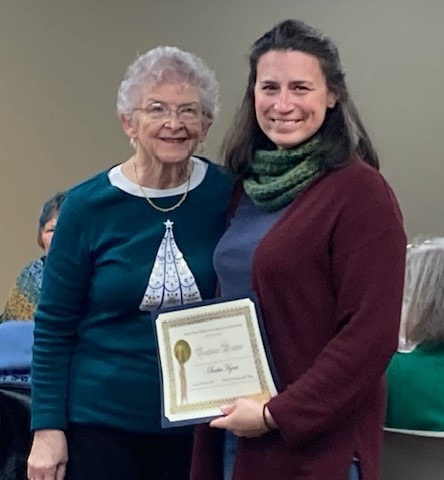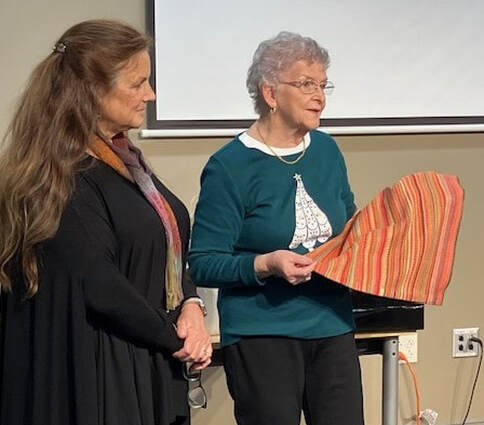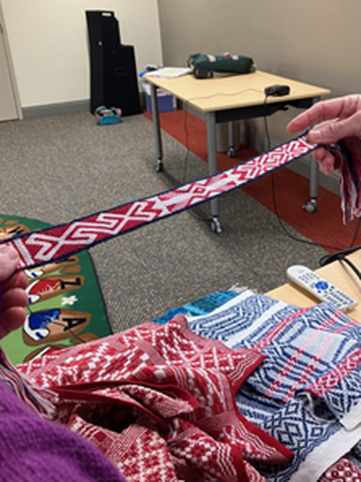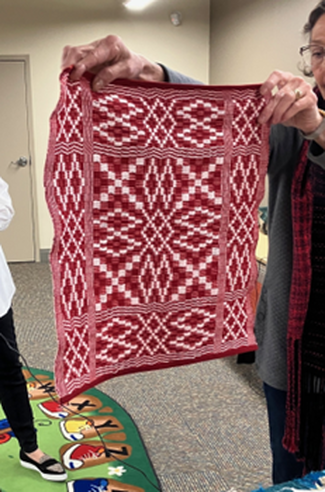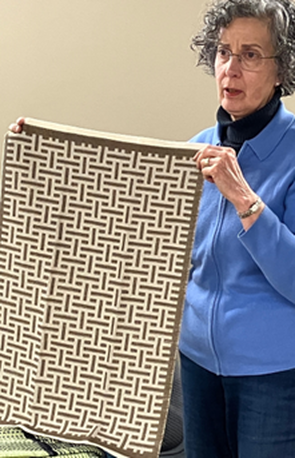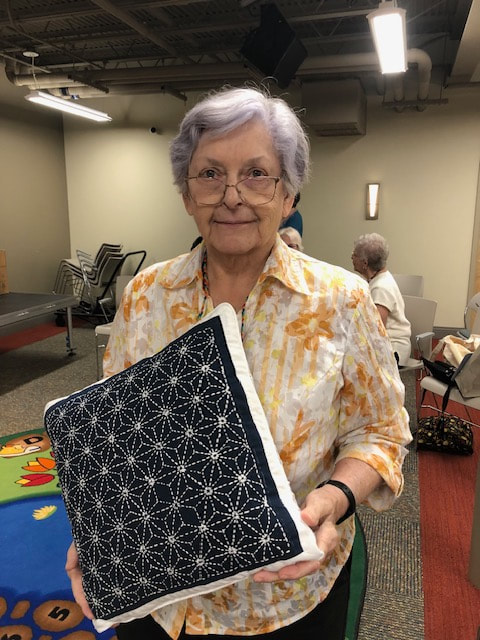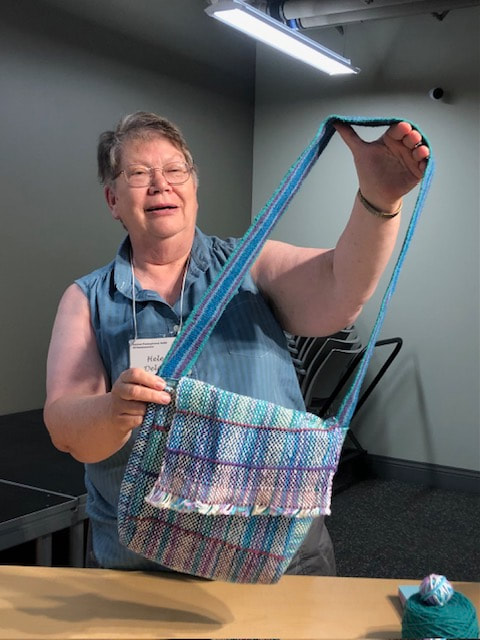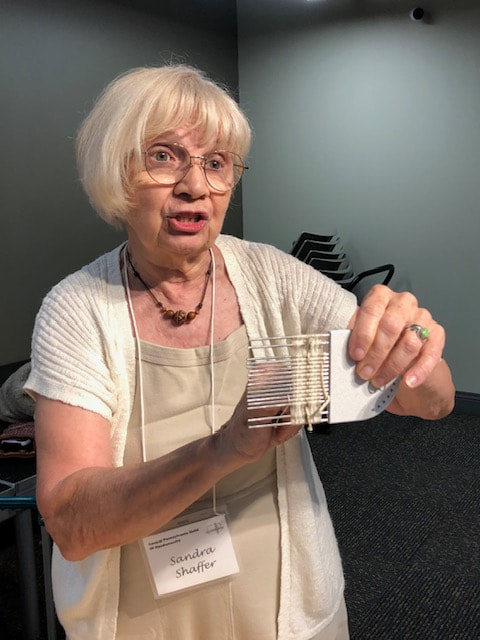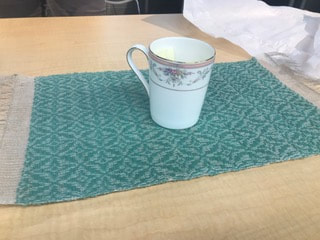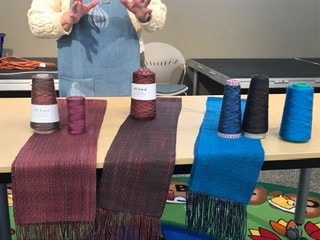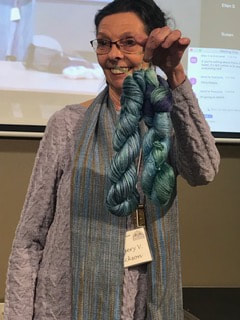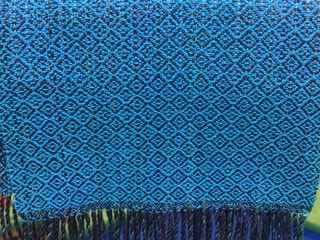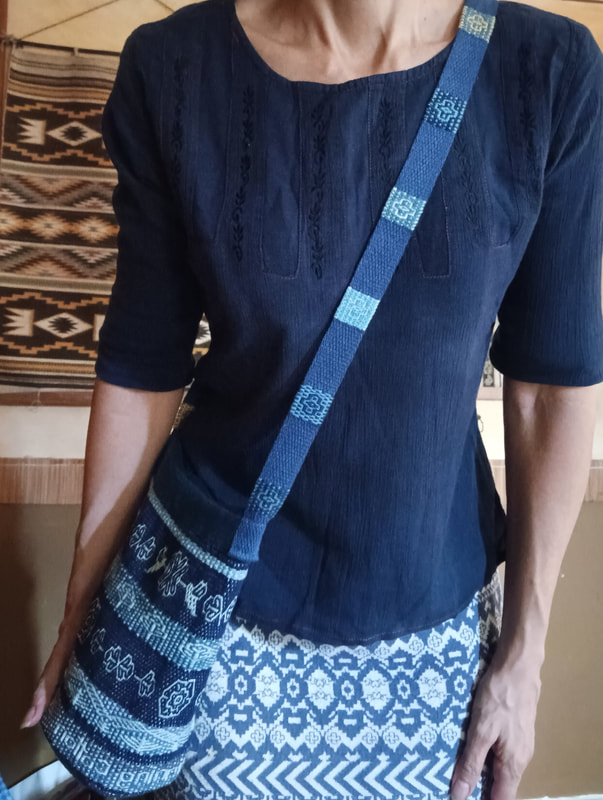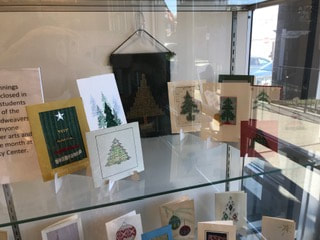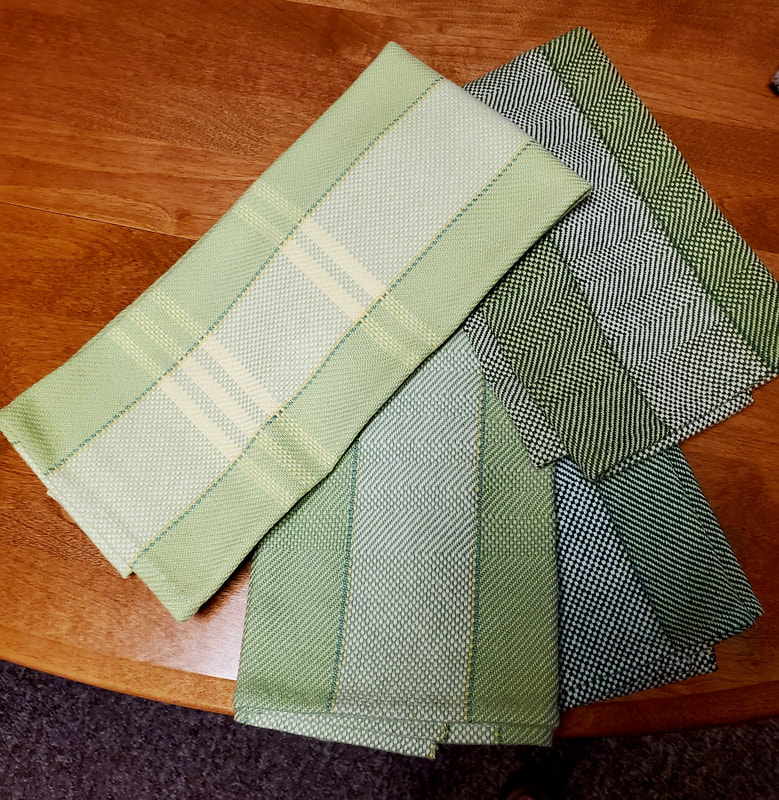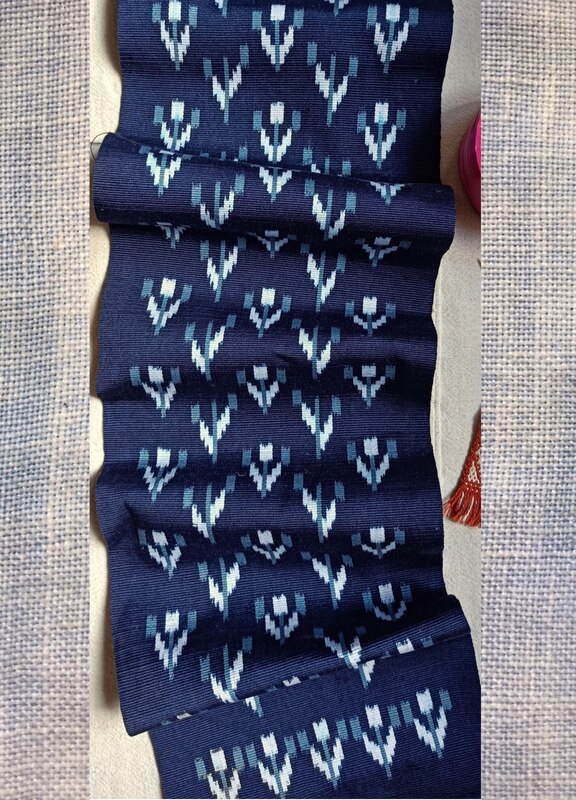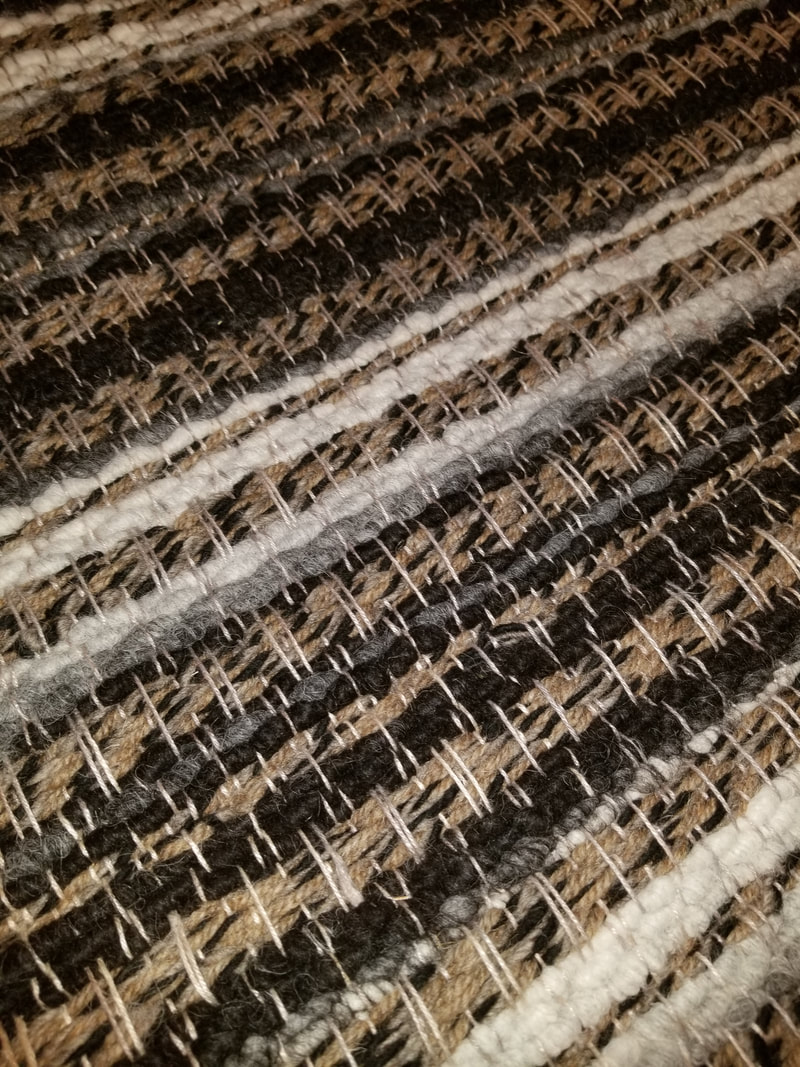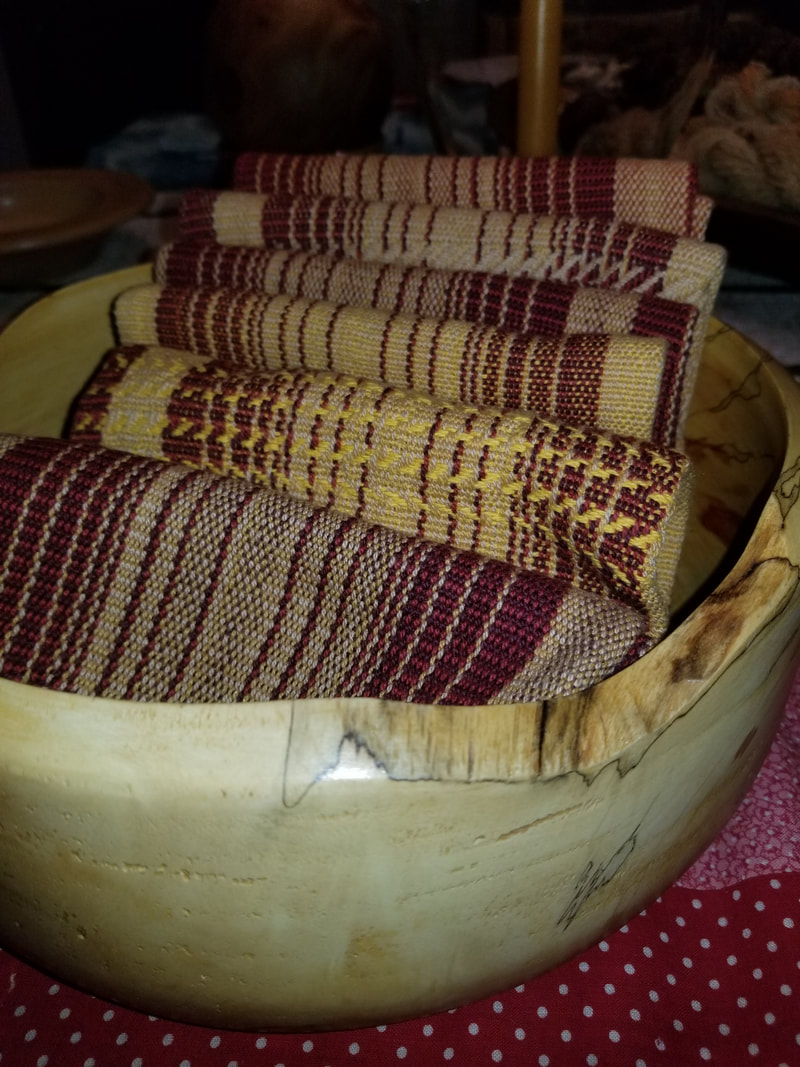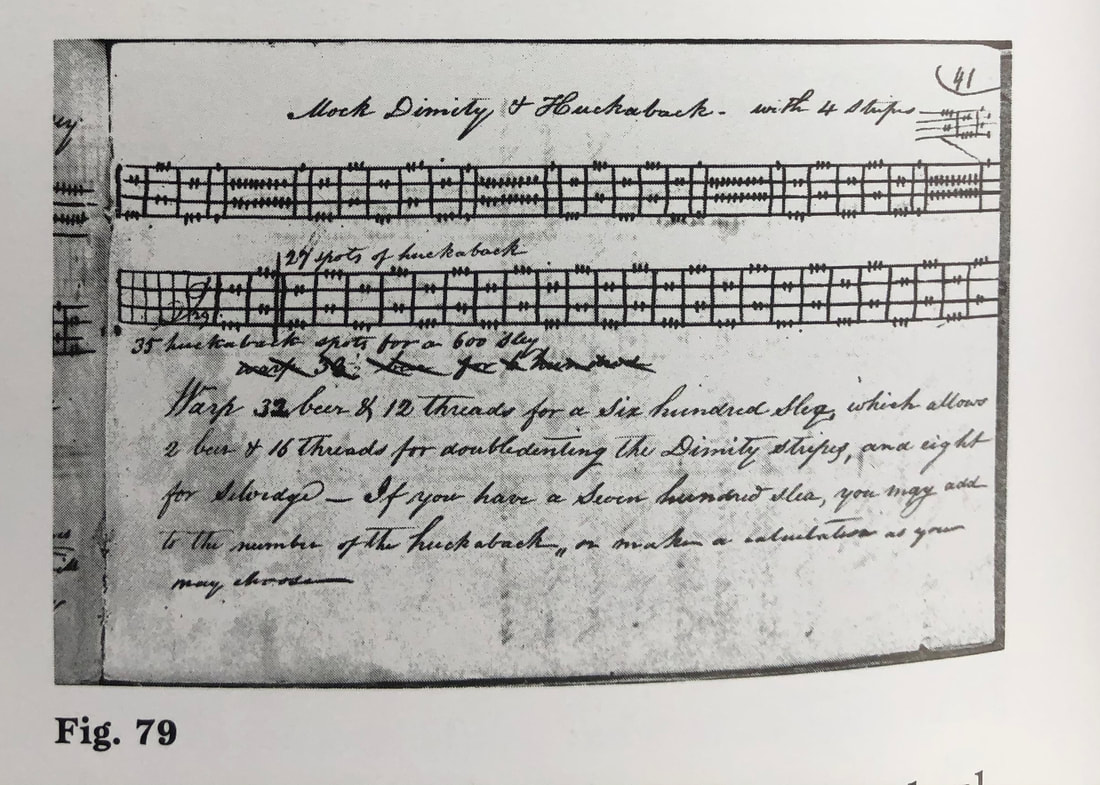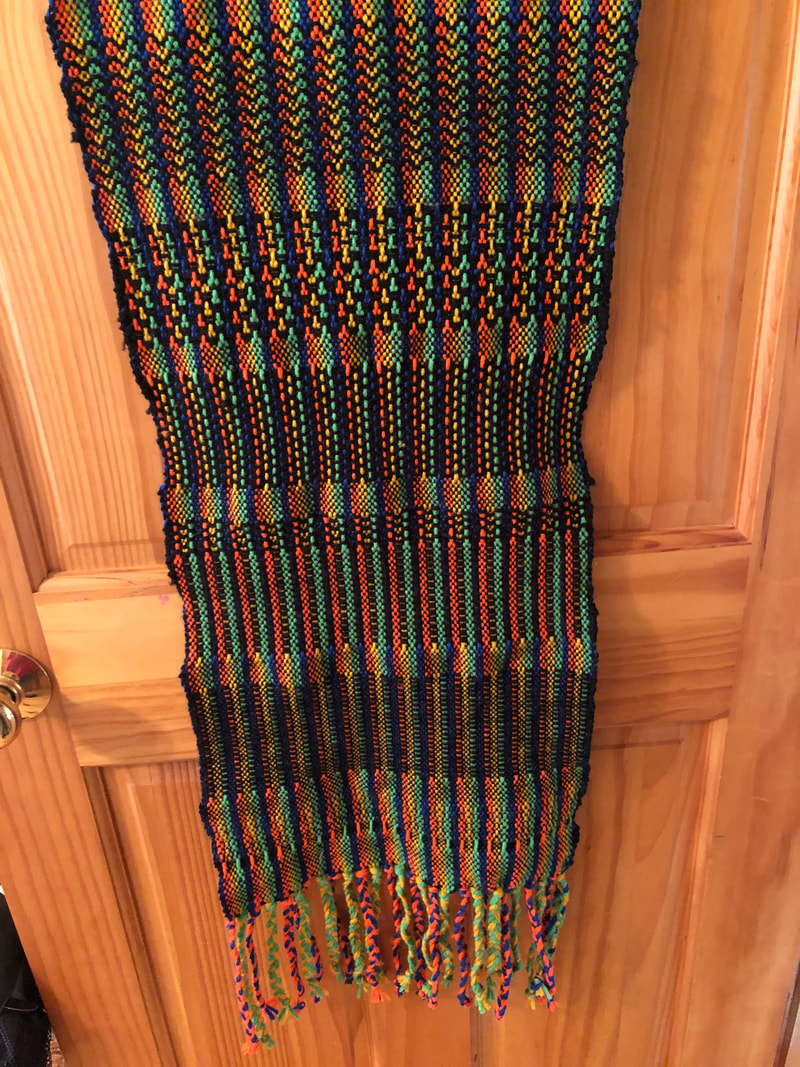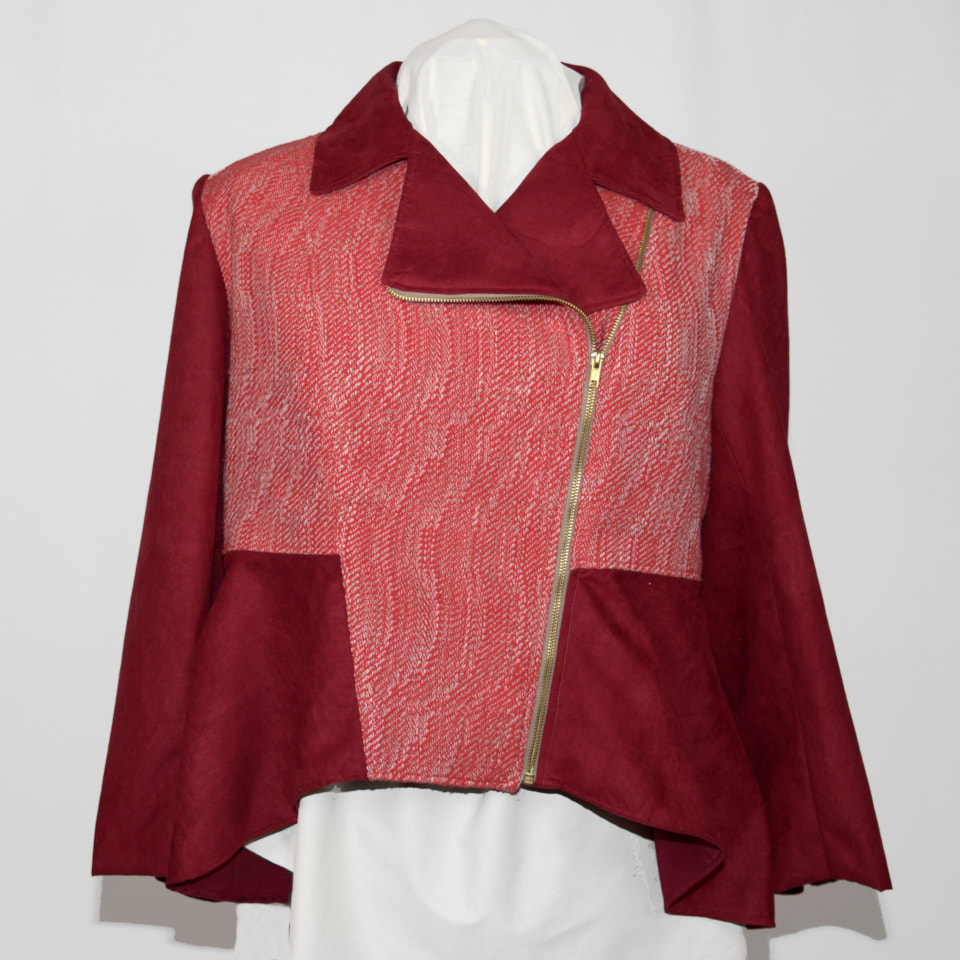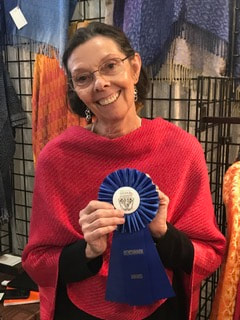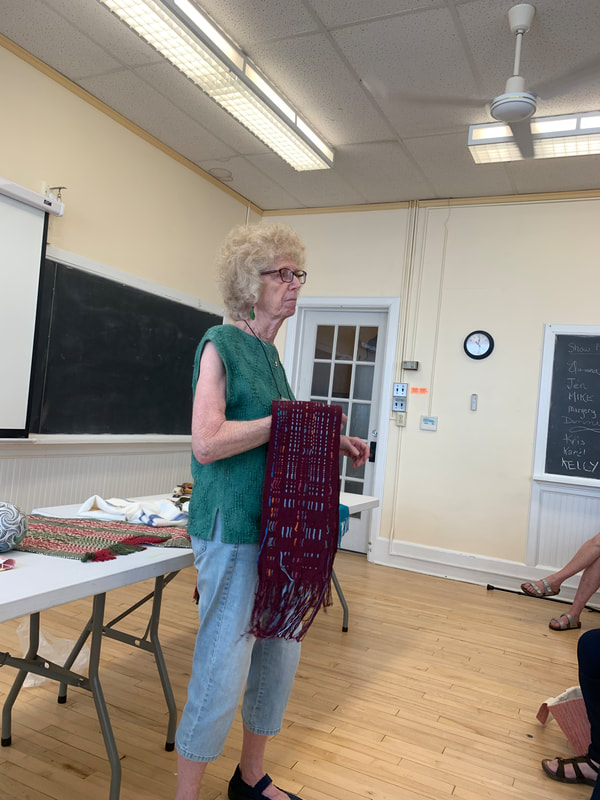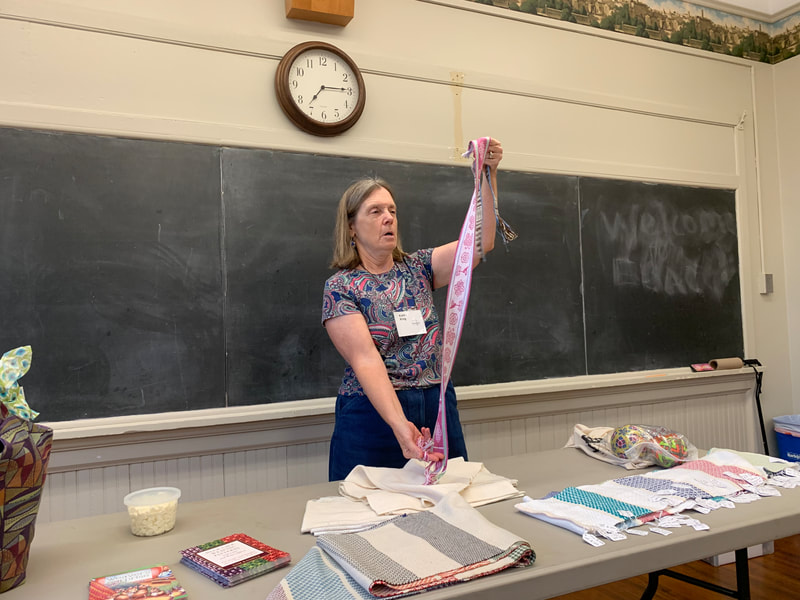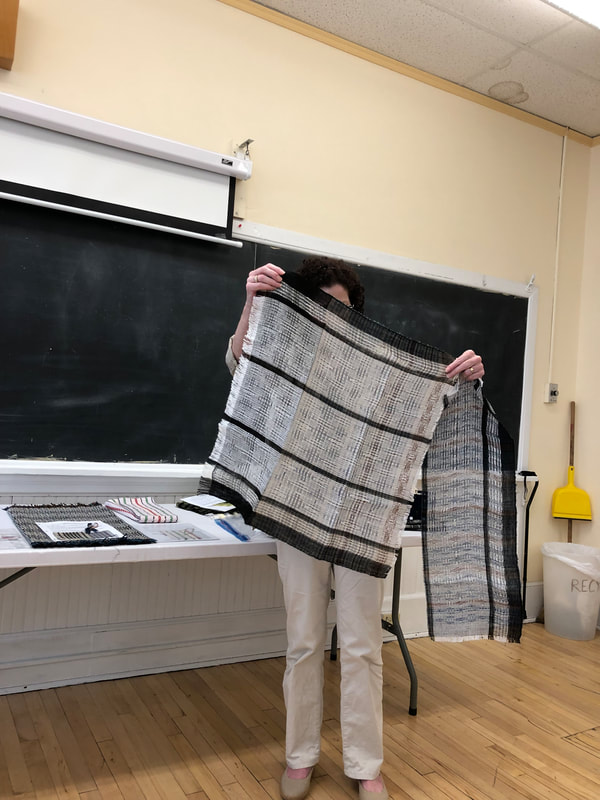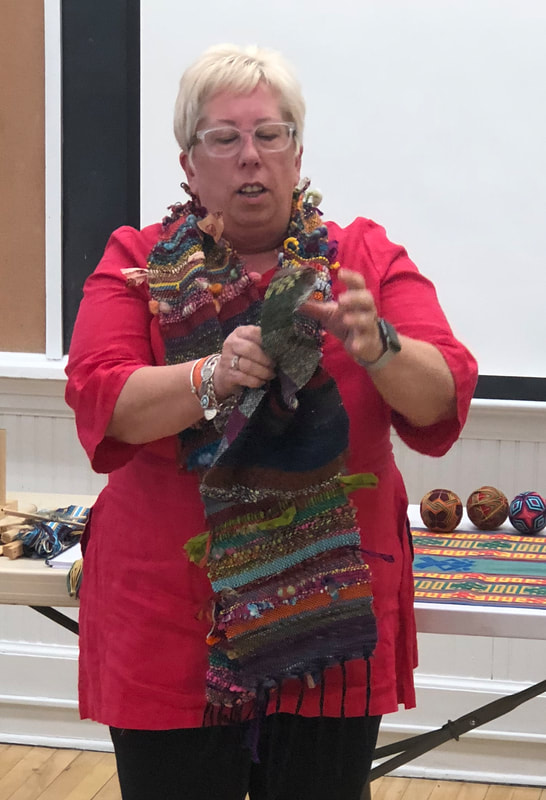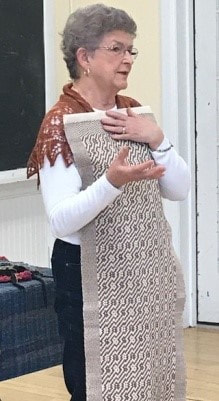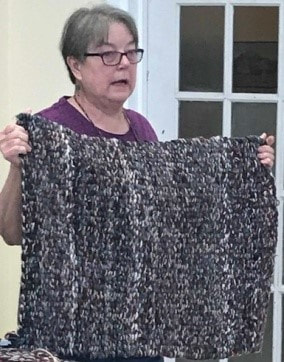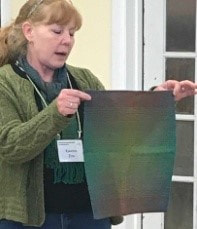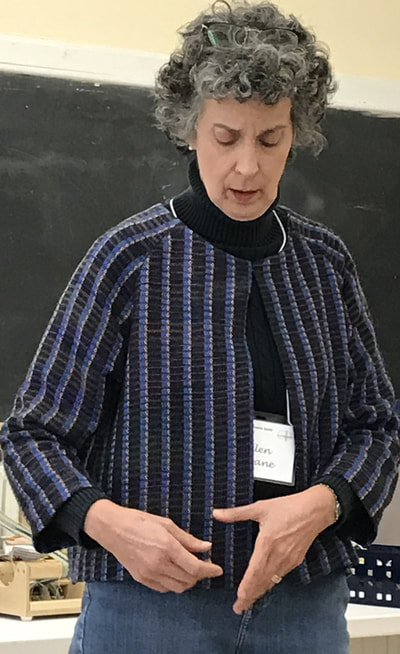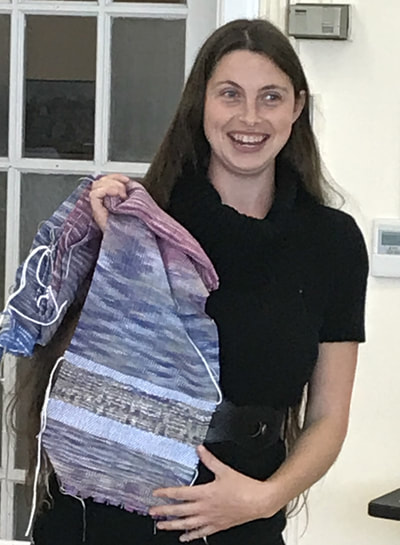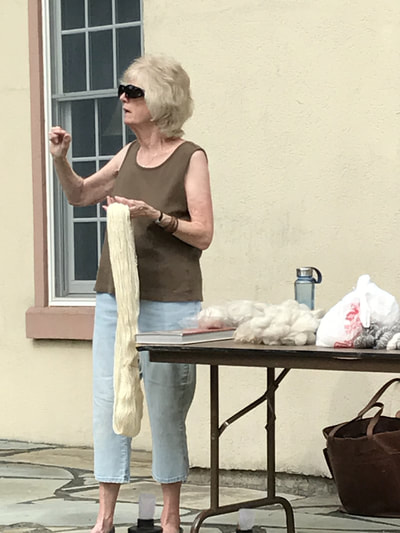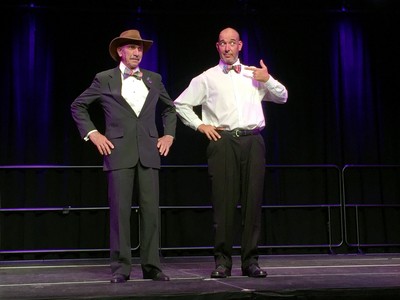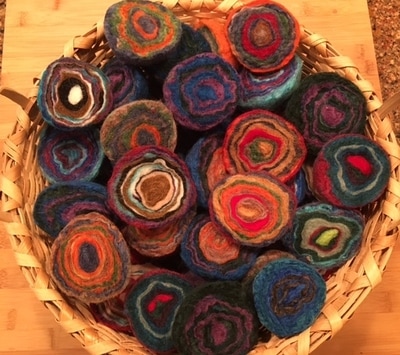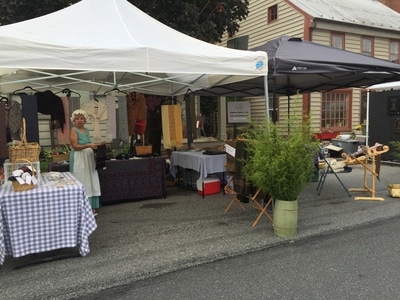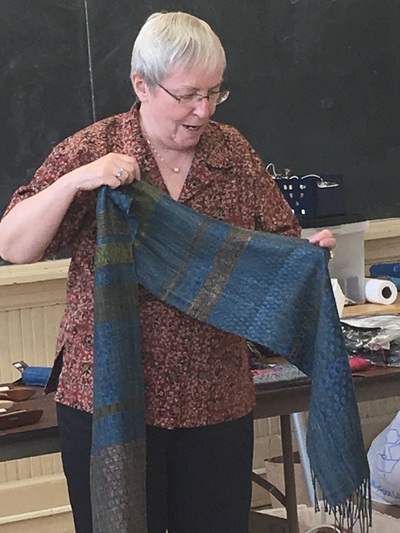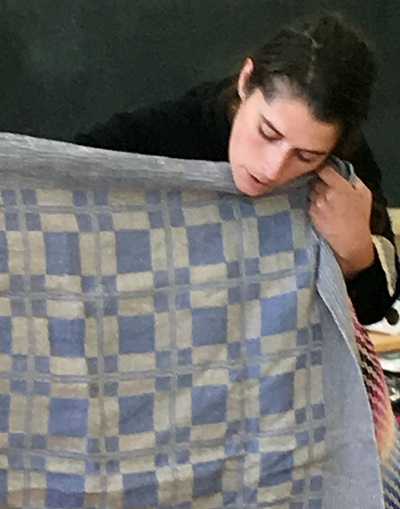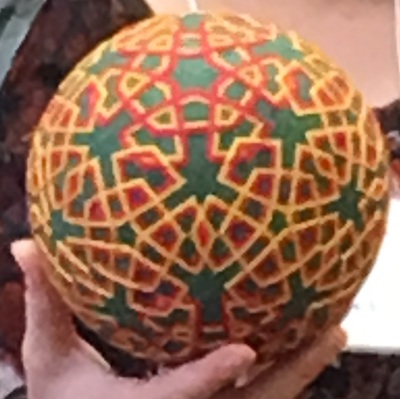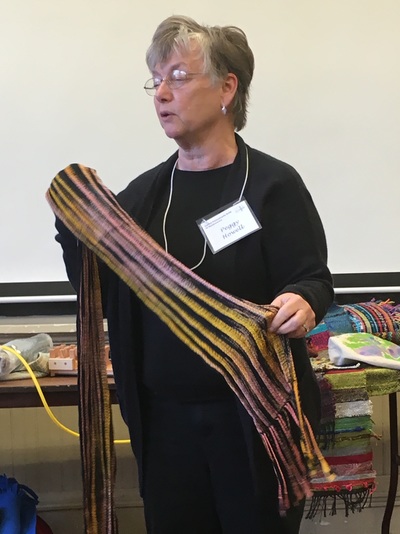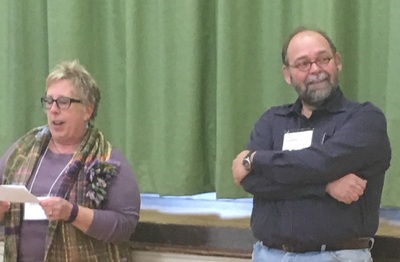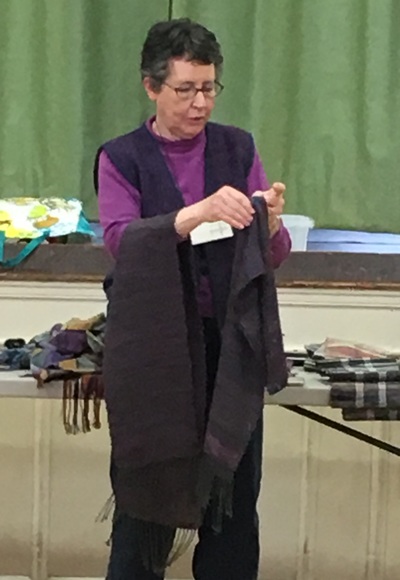The Central Pennsylvania Guild of Handweavers Photo Gallery
Show and Share - April 2024
Show and Share - March 2024
Show and Share - February 2024
Show and Share - January 2024
Holiday Party, GAP Awards, Exchange - December 2023
Show and Share - November 2023
Show and Share - October 2023
Show and Share - September 2023
Show and Share - August 2023
Show and Share - April 2023
Karel Henneberger showed some dyed silk scarves and temari Easter eggs.
Kelly Grotzinger showed some spring color experiments from 8/2 cotton using a fluorescent lime green, and three shawls from
the same warp using black, green and blue wefts.
the same warp using black, green and blue wefts.
Vessel Exchange - March 2023
|
Kris Peters to Barbara Diefenderfer. Barb’s garlic vessel inspired Kris to make a blue and white apron with garlic prints from a stamp Kris made. The apron is cotton.
Sandra Miller to Ellen Sloane. Ellen was present via Zoom. Ellen’ 60-year-old mug in black, blue and white showed well against Sandra’s placemat with a blue and white pinwheel design that she says she will never weave again.
Gerry Heefner to Christine Connelly. Christine’s pale green hand thrown rabbit mug inspired a towel in pink, green, white and orange.
Christine Forsythe to Laura Hart. Laura’s dainty porceline cup with blue flowers on the rim inspired a placemat with linen warp and bamboo weft.
Deb Lawson to Jane Flaherty. Jane’s hand thrown dusky blue mug inspired Deb to weave a table runner in an original design using 20/2 cotton at 60 epi with a four color warp.
Robin Lunger to Margie Mutmansky . The CPGH wine glass inspired a set of 8-shaft double weave mug rugs in white with red, yellow, green and white cotton in a rep weave from a 1992 Handwoven magazine.
Margie Mutmansky to Ralene Mitschler. Ralene’s rooster mug was the inspiration for Margie’s two rugs made of old sheets and flannel in burgundy and white with flecks of colors. Margie added a tea towel in red and orange.
|
Barbara Diefenderfer to Heather Watts. Heather’s thrift store mug inspired a block twill runner in orange, brown and gold.
Heather Watts to Sandra Miller. Sandra’s handblown glass had swirls of black with spots of color appliqued. Heather wove placemats in 4/4 cotton with a supplemental warp. The black and white mats had colored flecks from a ribbon yarn.
Christine Connelly to Kris Peters. Kris’s small ‘cookie-dunking’ oval pottery bowl by Fitzgerald was perfect against Christine’s tatami place mat and hot mat with blues against the bamboo splits.
Jane Flaherty to Laura Hart: The brown and white mug with blue flowers at the top inspired a blue runner with a green edging on 8-shafts.
Ralene Mitschler to Christine Forsythe. Ralene knit a mug rug to match Laura’s Japenese green tea cup.
|
Show and Share - March 2023
|
Barb Diefenderfer who will be teaching at MAFA on Point Twill made three scarves using point twill and variegated yarns in the warps. One used blue variegated yarn and a brown. Another used a rusty variegated yarn with pink. And one with a pink and orangy variegated.
Another scarf which was a Christmas present used a brassy yellow/orange wound with a burnt sienna and wove in twill with the burnt sienna. Margery Erikson wove a linen and bamboo scarf in white and variegated blues.
|
Sandy Miller used her first wool from her sheep to weave a shawl using wool from her Tunis sheep as weft in a goose eye design against the red and black 8/2 cotton warp.
|
Show and Share - February 2023
Kelly Grotzinger made a rug using fabric strips and a blanket made with rug wool from a single warp.
Kris Peters made towels using a plaited twill using 8/4 cotton, and played with a hand-dyed warp of medical grade cotton.
Laverne Waddington
East Berlin Library Exhibit
Show and Share - December 2022
Laverne Waddington was asked to make a case for a flute. She tested the design by making a dark and light blue band on her backstrap loom using a snake motif that is common to the area. The actual case was in red and black. She wove two strips at the same time, then sewed them together for the case. She also made narrower strips to decorate the flute itself. Laverne has been trying to get a real red from cochineal, but so far has managed to make some pinks and purples and an orange on silk.
Barbara Diefenderfer showed her current Christmas card. She also showed off a scarf she made from some old strange orange/brassy gold yarn which she alternated in the warp with a rust tencel thread which tamed the brassy color.
Show and Share - November 2022
Robin Lunger
Laverne Waddington
Show and Share - October 2022
Karel Henneberger
Laura Campbell - Summer and Winter towels
Show and Share - September 2022
Margery Erickson
Barbara Diefenderfer
Online Show and Share - August 2022
Laverne Waddington: An ikat small purse project using white 20/2 cotton warp tied and dyed in light and dark blue. The 880 ends were woven on a backstrap loom which allowed the design to show mostly clear images with only a slight slipping of the dyed sections.
Online Show and Share - July 2022
Laverne Waddington: A scarf woven on her back strap loom showed green tea leaves with no repeat and butterflies.
Kelly Grotzinger: 8/4 natural linen warp hand dyed with Dharma’s mushroom fiber reactive dye. a modified chicken tracks pattern from Tom K’s book on rag rugs. weft is either 1) alpaca core spun yarn (bumps) in repeating intervals of black, dark brown, charcoal, silver, and creamy white or 2) multiple shots of alpaca core spun alternating with multiple shots of 3 strands of singles wool rug yarn (taupe, black, gray) plied into one fat strand.
Kathy King used 20/2 wool in turquoise and rust variegated warp and wanted shades of
gold for the weft, so she dyed some wool allowed it to sit for six hours as she couldn’t wait the
entire suggested 12 hours. YIPES! Orange. Using a pattern from 60 Scarves for 60 Years, she
wove the orange across the turquoise and rust warp. The result is iridescent. A second scarf
woven also using a pattern from 60 Scarves for 60 Years used JoJo cobweb lace yarn variegated.
There were no repeats. She use a lavender weft with some varigation.
gold for the weft, so she dyed some wool allowed it to sit for six hours as she couldn’t wait the
entire suggested 12 hours. YIPES! Orange. Using a pattern from 60 Scarves for 60 Years, she
wove the orange across the turquoise and rust warp. The result is iridescent. A second scarf
woven also using a pattern from 60 Scarves for 60 Years used JoJo cobweb lace yarn variegated.
There were no repeats. She use a lavender weft with some varigation.
Online Show and Share - April 2022
Kelly Grotzinger showed first a long line of bobbins filled with leftover yarns of all sizes and colors, mercerized and unmercerized, including several whites. She wove towels using the whites for warp and each towel had different shades and tints of a single color from the bobbins. She wove 18 epi and nearly squared the designs. She advised choosing transitions from one bobbin color to another and to limit the treadling options in one towel. You don’t have to think a lot, she said, but you do have to think a little.
Kris Peters spun some alpaca she had carded and plied it Navajo style, then wove it in natural browns and white. This was her CoVid effort.
Deb Lawson produced a purple tree with her new 3-D printer to hold her ½” bobbin lace made of 40/2 linen.
Online Show and Share - March 2022
Kelly Grotzinger:
The gold/maroon/rust/tan napkins were designed around three gradients--2 predominantly red-brown on the left and right sides of a central predominantly gold gradient. Gradients can be woven using only 2 shafts in plain weave with 2 contrasting colors of thread. Threading on 4 shafts and using a twill tie-up allows one to weave decorative borders when one has had enough plain weave. Weft colors were chosen within the same color family or range resulting in subtle differences in the color of the cloth.
The navy or dark royal blue/natural tan napkins and runner were woven in 16/2 unmercerized cotton. The ‘dog bone’ pattern (a better description than calling it an I-beam) is only one of 4 produced when an 8 shaft point twill threading in alternating light and dark threads is treadled TAW. Reversing the starting color from dark to light results in a different look; the back of the cloth differs from the front of the cloth. 8 napkins and a runner were woven using white to gold to variegated blues to tan to olive thread as weft.
The gold/maroon/rust/tan napkins were designed around three gradients--2 predominantly red-brown on the left and right sides of a central predominantly gold gradient. Gradients can be woven using only 2 shafts in plain weave with 2 contrasting colors of thread. Threading on 4 shafts and using a twill tie-up allows one to weave decorative borders when one has had enough plain weave. Weft colors were chosen within the same color family or range resulting in subtle differences in the color of the cloth.
The navy or dark royal blue/natural tan napkins and runner were woven in 16/2 unmercerized cotton. The ‘dog bone’ pattern (a better description than calling it an I-beam) is only one of 4 produced when an 8 shaft point twill threading in alternating light and dark threads is treadled TAW. Reversing the starting color from dark to light results in a different look; the back of the cloth differs from the front of the cloth. 8 napkins and a runner were woven using white to gold to variegated blues to tan to olive thread as weft.
Gay McGeary: Huck and dimity hand towels
Mary Parsons shared a bumberet sample from Robyn Spady’s workshop.
Barb Diefenderfer shared towels made with stash-busting strips on an 8-shaft straight threading.
Online Show and Share - February 2022
Deb Lawson showed a jacket she wove and had constructed in an orange fabric and burgundy microsuede. The orange was leftover and there wasn’t enough for the entire jacket so she used the suede as a frame to accent the handwoven fabric made of linen and silk noil. The 20/2 cotton warp at 60 epi with twill stripes at 78 epi gave a slight ikat appearance when shafts
were moved. The weft was 20/2 cotton and one with copper wire. There is little drape. The colors changed once woven. The orange and greens got more yellow . The selvedges are bad as wire doesn’t weave neatly. This was an experiment at first, then it was for the HGA yardage. (would it make a good dividing screen?) Yes. The texture is much like a screen.
were moved. The weft was 20/2 cotton and one with copper wire. There is little drape. The colors changed once woven. The orange and greens got more yellow . The selvedges are bad as wire doesn’t weave neatly. This was an experiment at first, then it was for the HGA yardage. (would it make a good dividing screen?) Yes. The texture is much like a screen.
Barbara Richter wove Inkle bands in twill patterns on WeaveIt Looms. She used three colors in each band – requiring much thinking as the weaving progresses.
Online Show and Share - May 2020

By MaryAnne King
Kris Peters had given me a lined silk dress which I cut in 1/2" strips and wove into a shawl with a variegated tencel warp and weft (plain weave, 20 epi; 1 pick silk, 2 picks tencel, "Spice Combo" from Yarn Barn). The draft for the rag rug is from Handwoven Design Collection 8 for a table runner (pp. 4-5), although I changed it to use only black and red 8/4 cotton in the warp and all black for every other pick in the weft with very colorful fabric I found at Creative Reuse.
By Kelly Grotzinger
To answer the question of what I have been working on, several photos are attached: a runner rug, a pillow case, a shawl. The photos reveal that I put on a long-ish rug warp and by the end, had to use that warp creatively, shall we say! Both warp and weft were chosen with an eye toward using stash (rug wool from an auction in Bowmansville PA) and weaving a Krokbragd runner. The design is based on a draft from Handwoven Jan/Feb 1997. I will confess that I rearranged the color sequence for the rug up until the time that I wove a sample, despite a fair amount of wrapping, planning, and evaluating color value before starting to weave. I did not test wash my wool thus I did not anticipate that my rug wool would wash beautifully--cushy and soft--maybe not so good for the floor. The pillow started out life as tote fabric--cushy and soft--again, not so good for a tote. One photo is of the shawl made of white and sparkly skeins of mixed fiber from a Pine Grove PA 'mill' and white mohair, woven in Krokbragd (believe it or not) on the charcoal waxed wool rug warp. The latter speaks to the creative use of stash and warp. I learned much about the wools, weaving with mohair, using insufficiently twisted skeins of unknown fiber, and using waxed wool rug warp. I confirmed something we all know--extensive planning does not always result in projects as envisioned! So, long live the creative process, our flexibility to invent and change, and deep closets for storing the results!
To answer the question of what I have been working on, several photos are attached: a runner rug, a pillow case, a shawl. The photos reveal that I put on a long-ish rug warp and by the end, had to use that warp creatively, shall we say! Both warp and weft were chosen with an eye toward using stash (rug wool from an auction in Bowmansville PA) and weaving a Krokbragd runner. The design is based on a draft from Handwoven Jan/Feb 1997. I will confess that I rearranged the color sequence for the rug up until the time that I wove a sample, despite a fair amount of wrapping, planning, and evaluating color value before starting to weave. I did not test wash my wool thus I did not anticipate that my rug wool would wash beautifully--cushy and soft--maybe not so good for the floor. The pillow started out life as tote fabric--cushy and soft--again, not so good for a tote. One photo is of the shawl made of white and sparkly skeins of mixed fiber from a Pine Grove PA 'mill' and white mohair, woven in Krokbragd (believe it or not) on the charcoal waxed wool rug warp. The latter speaks to the creative use of stash and warp. I learned much about the wools, weaving with mohair, using insufficiently twisted skeins of unknown fiber, and using waxed wool rug warp. I confirmed something we all know--extensive planning does not always result in projects as envisioned! So, long live the creative process, our flexibility to invent and change, and deep closets for storing the results!

By Gloria Oldenburg
Weaving for granddaughter Kara for her wedding! Tencel 30epi. 22”wide pattern from 60 scarves for 60 years. Now twisting the many, many fringes!
Weaving for granddaughter Kara for her wedding! Tencel 30epi. 22”wide pattern from 60 scarves for 60 years. Now twisting the many, many fringes!
Yoga for Weavers and Social (via zoom-a-zoom-a-zoom-a-zoom) - May 2020
The Charm and Versatility of Point Twills
by Barbara Diefenderfer
by Barbara Diefenderfer
As part of the February 2020 meeting, CPGH member Barbara Diefenderfer gave an informative presentation on Point Twill Weaves and how to create patterns using various tie-ups and treadlings.
She displayed and discussed a number of examples and gamps showing just some of the numerous possibilities.
Thank you Barbara, for your continued generosity and dedication to The Central PA Guild of Handweavers!
FYI:The Weavers’ Roundtable, a "sister" weavers guild located in Hagerstown MD
will be offering a Point Twill Workshop, taught by Barbara Diefenderfer, at the Washington County Museum of Fine Arts in Hagerstown, MD on March 26, 2020.The cost is $25 donation to the museum and $15 for the workbook. See registration details at the CPGH blog or online at Washington County Fine Arts.
She displayed and discussed a number of examples and gamps showing just some of the numerous possibilities.
Thank you Barbara, for your continued generosity and dedication to The Central PA Guild of Handweavers!
FYI:The Weavers’ Roundtable, a "sister" weavers guild located in Hagerstown MD
will be offering a Point Twill Workshop, taught by Barbara Diefenderfer, at the Washington County Museum of Fine Arts in Hagerstown, MD on March 26, 2020.The cost is $25 donation to the museum and $15 for the workbook. See registration details at the CPGH blog or online at Washington County Fine Arts.
2020 CPGH Handwoven Towel Exchange
This past October CPGH members Robin Leidner and Rose Meagher suggested having a membership towel exchange.
Robin and Rose collected hand woven towels from 20 participants before the February 2020 meeting started. They photographed the towels and then concealed them in bags for random distribution.
Much to everyone's delight, there were 29 towels exchanged!
Rose and Robin then produced a booklet in pdf format for distribution to the participants. The booklet contains photos of each towel along with the towel's documentation.
Thank you Robin and Rose!
Robin and Rose collected hand woven towels from 20 participants before the February 2020 meeting started. They photographed the towels and then concealed them in bags for random distribution.
Much to everyone's delight, there were 29 towels exchanged!
Rose and Robin then produced a booklet in pdf format for distribution to the participants. The booklet contains photos of each towel along with the towel's documentation.
Thank you Robin and Rose!
Weaving Wabi Sabi
The 2020 Pennsylvania Farm Show's Sheep to Shawl Competition was especially entertaining this year because CPGH had members on each of the three Lancaster Spinners and Weavers Guild teams! Team Weaving Wabi Sabi featured CPGH member Tara Kiley-Rothwell (Weaver).
Theme: “That 70s Shawl”
Shearer: Chris Stitzel
Weaver: Tara Kiley-Rothwell
Spinners: Donna Walton-Gibbs, Dayna Reidenouer, & Jen Maurer
Carder: Jill Wilson
This year our theme was "THAT 70's SHAWL".
Early in the design/ planning process we decided to go with all natural/un-dyed fiber.
As the design came together, it was remarked that it looked like... a 70's shawl. Voila- a theme was born! Once we had the theme it was fun to put together the 70's goodies for our display and costumes.
Our warp was entirely handspun by the team in several shades of Romney provided by
Samantha J's Fiber Farm.
*See March 2020 edition of CPGH Newsletter, The Weaver's Knot, for more details.
Theme: “That 70s Shawl”
Shearer: Chris Stitzel
Weaver: Tara Kiley-Rothwell
Spinners: Donna Walton-Gibbs, Dayna Reidenouer, & Jen Maurer
Carder: Jill Wilson
This year our theme was "THAT 70's SHAWL".
Early in the design/ planning process we decided to go with all natural/un-dyed fiber.
As the design came together, it was remarked that it looked like... a 70's shawl. Voila- a theme was born! Once we had the theme it was fun to put together the 70's goodies for our display and costumes.
Our warp was entirely handspun by the team in several shades of Romney provided by
Samantha J's Fiber Farm.
*See March 2020 edition of CPGH Newsletter, The Weaver's Knot, for more details.
The Fidget Spinners
The 2020 Pennsylvania Farm Show's Sheep to Shawl Competition was especially entertaining this year because CPGH had members on each of the three Lancaster Spinners and Weavers Guild teams! The Fidget Spinners, featuring CPGH members Kelly Czyzewski (Weaver) and Tina Mickley (Spinner), both seated in the picture. The team placed 3rd in the competition.
Theme: “Looking Through the Window at Christmas”
Shearer: Dale Mylin
Weaver: Kelly Czyzewski
Spinners: Tina Mickley, Emily Ellen, Tracy Beck
Carder: Kati Green
Our team began working on our Sheep to Shawl project in early 2019. We collectively decided on a Christmas theme around the month of July. Hmmmmm......Christmas in July! The official theme became: “Looking Through the Window at Christmas”. We worked together to plan a display and the shawl design. Our motto is: “Go Big or Go Home” therefore, we make our displays as large as possible. This year we featured a window, Christmas tree, and a fake fireplace with stockings.
We purchased most of the dyed warp fiber from Samantha J’s Fiber Farm. The warp fiber is 100% Corriedale wool. Tina and Kelly hand dyed the lighter green and red warp yarns.
The team worked together to spin & ply every warp thread used, for both the practice shawl and the competition shawl. We chose a Coopworth sheep named Mazal for her fleece to be used for our weft yarns.
*See the February 2020 edition of the CPGH Newsletter, The Weaver's Knot, for more details
Theme: “Looking Through the Window at Christmas”
Shearer: Dale Mylin
Weaver: Kelly Czyzewski
Spinners: Tina Mickley, Emily Ellen, Tracy Beck
Carder: Kati Green
Our team began working on our Sheep to Shawl project in early 2019. We collectively decided on a Christmas theme around the month of July. Hmmmmm......Christmas in July! The official theme became: “Looking Through the Window at Christmas”. We worked together to plan a display and the shawl design. Our motto is: “Go Big or Go Home” therefore, we make our displays as large as possible. This year we featured a window, Christmas tree, and a fake fireplace with stockings.
We purchased most of the dyed warp fiber from Samantha J’s Fiber Farm. The warp fiber is 100% Corriedale wool. Tina and Kelly hand dyed the lighter green and red warp yarns.
The team worked together to spin & ply every warp thread used, for both the practice shawl and the competition shawl. We chose a Coopworth sheep named Mazal for her fleece to be used for our weft yarns.
*See the February 2020 edition of the CPGH Newsletter, The Weaver's Knot, for more details
Thanks to Tina Mickley!
CPGH member Tina Mickley applied for and was awarded an opportunity to participate in a class by the scholarship committee for MAFA 2019 held at Millersville University this past July. One of the requirements for the scholarship is that the participant share what they experienced and learned in the form of a presentation for the Weaver's Guild who sponsored them.
Tina attended the MAFA workshop: "2, 3, 4: A Lot of Interesting Older Weave Structures on Less Shafts" instructed by Marjie Thompson.
Tina provided an interesting, fact-filled presentation and shared her class notebook and textile samples from her personal collection. Guild members were treated to examining older weave structures like crossbar dimity, and understanding the use of 3 shaft weave structures woven on counterbalance looms!
Tina attended the MAFA workshop: "2, 3, 4: A Lot of Interesting Older Weave Structures on Less Shafts" instructed by Marjie Thompson.
Tina provided an interesting, fact-filled presentation and shared her class notebook and textile samples from her personal collection. Guild members were treated to examining older weave structures like crossbar dimity, and understanding the use of 3 shaft weave structures woven on counterbalance looms!
Jen Weber wins award at Akita National Temari Competition
More details and photos can be found in the CPGH January 2020 newsletter, or here at Jen's blog
Enjoying the Holiday Name Draft Weaving Challenge Runners
The weaving name draft "Happy Holidays and New Year" came from the 2018 CPGH Christmas Card designed by Michael Rupp with the assistance of Jen Weber.
Table runner weavers were: Carol LaPorte, Karel Henneberger, Deb Lawson, Michael Rupp, Susan Kesler-Simpson, Barbara Diefenderfer and Tina Mickley.
Thanks to all for your beautiful contributions to the Holiday lunch!
Table runner weavers were: Carol LaPorte, Karel Henneberger, Deb Lawson, Michael Rupp, Susan Kesler-Simpson, Barbara Diefenderfer and Tina Mickley.
Thanks to all for your beautiful contributions to the Holiday lunch!
Many thanks to our special Elves this year for helping ring in the holidays!
Our friends "D" (aka Wayne Lunger) and "E" (aka Robin Lunger) host the gift exchange
Congratulations to Lynne Kellerman and Tina Mickley
for their GAP Achievement
for their GAP Achievement
Barbara Diefenderfer presented Tina Mickley and Lynne Kellerman with their Beginner Level GAP certifciates, December 4, 2019.
Margery Erickson wins PA Guild of Craftsmen Fine Craft Fair Award
Master Artisan Margery Erickson won the award for "Resolved Design"
Resolved Design shows good composition and artistic excellence. Choice of materials and methods shows innovation and mastery. Criteria for reproduction or original interpretation of traditional work include both the use of materials that are appropriate to the period and style and documentation to support the traditional style of the work being interpreted or reproduced.
Check out Margery's websites for some great inspiration:
http://opalessencefiberstudio.com/
https://www.etsy.com/shop/maverickson
Resolved Design shows good composition and artistic excellence. Choice of materials and methods shows innovation and mastery. Criteria for reproduction or original interpretation of traditional work include both the use of materials that are appropriate to the period and style and documentation to support the traditional style of the work being interpreted or reproduced.
Check out Margery's websites for some great inspiration:
http://opalessencefiberstudio.com/
https://www.etsy.com/shop/maverickson
SEPTEMBER 2019 SHOW AND SHARE
AUGUST 2019 SHOW AND SHARE
TOM KNISELY'S AUGUST 2019 PROGRAM: SAME THREADING, MULTIPLE TREADLINGS
JUNE 2019 POT LUCK PICNIC & CAST-OFFS SALE
MAY 2019 SHOW AND SHARE
A FEW HIGHLIGHTS FROM THE MAY 2019 SAMPLE EXCHANGE
Thank you, Tassel team !
We had an initial goal of creating about 80 tassels and this team knocked it out of the park by creating 160! Woo-hoo! Thanks to everyone who helped make tassels, who donated thrums for making tassels, who helped assemble our tassel/clip/card finished product at April's meeting, and to Karel for donating the clips! It was a fantastic success. These gifts from CPGH will be included in MAFA attendees "Goody Bags"
april show and share
tapestry weaving - cherly migliarini
Cheryl shared her vast knowledge of tapestry weaving, her creativity and her artistic skills through a series of her own tapestries and examples of tapestry weaving looms and equipment. She answered numerous questions from a thoroughly engaged, inspired and motivated audience. Cheryl ended her program by explaining why she weaves tapestry.
"It is historical, has color, makes pictures, and offers the weaver an opportunity to ‘weave a diary’
as well as provide a language for their vision".
Thank You Cheryl!
"It is historical, has color, makes pictures, and offers the weaver an opportunity to ‘weave a diary’
as well as provide a language for their vision".
Thank You Cheryl!
March 2019 show and share
warp painting with nancy farr begnini
March 2019
Nancy earned a Bachelor of Arts degree in Fiber Art from Kent State University (Kent, Ohio). She has been weaving for more than 35 years and has also worked in other media, including silk screen and photo silk screen, paper and cloth batik, and encaustic. She has worked extensively
with dyes, both synthetic and natural, including organic indigo.
Through many years devoted to raising two sets of twins, Nancy continued weaving and other artistic pursuits whenever time and space permitted. With children now grown, she is weaving and dyeing full time in her home studio. She particularly enjoys working in woven shibori using both synthetic and natural dyes. She has also widely researched and experimented with eco-printing techniques.
with dyes, both synthetic and natural, including organic indigo.
Through many years devoted to raising two sets of twins, Nancy continued weaving and other artistic pursuits whenever time and space permitted. With children now grown, she is weaving and dyeing full time in her home studio. She particularly enjoys working in woven shibori using both synthetic and natural dyes. She has also widely researched and experimented with eco-printing techniques.
2018 holiday party!
warped face weaves and their possibilities by Deb Lawson
November 2018
CPGH member, Deb Lawson, shared her experiences with the final level of the GAP program which earned her Master Weaver Status. Deb (with the help of her handsome assistant) shared her process for how she decided on her final topic. She described the wandering and rabbit holes she encountered along the way. Her Power Point presentation with illustrations detailed how she designed, modified and finagled to produce her master woven piece that went with the final paper.
November 2018 - show and share
gap certificates for Pat Flynn and carrie varner - congrats!
May 2018 Guild meeting - Show and share
jacquard weaving - from concept to finished fabric
april 2018
Carrie Varner graduated from the Philadelphia Textile College and worked for ten years at Hoffman Mill in Shippensburg PA, as a Jacquard textile designer in their art department. Carrie presented how a Jacquard loom works and described how to design weave structures for a Jacquard fabric. She provided many samples, pictures and descriptions of the design process and how it is staged at a textile manufacturing mill.
Thank you, Carrie!
Thank you, Carrie!
show and share
april 2018
unusual fibers for handwoven textiles
January 2018
Sarah Bixler, owner and resident instructor at Red Stone Glen Fiber Arts Center, generously gave of her time and talents to inspire fellow Guild members to "think outside of the yarn box" when designing and weaving textiles.
Members were treated to numerous examples of what happens when you experiment with non-traditional fibers in hand weaving.
Thank you, Sarah!
Members were treated to numerous examples of what happens when you experiment with non-traditional fibers in hand weaving.
Thank you, Sarah!
Canadian, eh?
November 2017
At our November 2017 meeting, Kathy King (left) shared one of her many weaving contacts and friends with us. Her good friend Jette Vandermeiden, is a widely respected weaving teacher from Canada, who gave us a tour of various Canadian weaving traditions in a delightful presentation entitled “Canadian, Eh?” Canada has its own unique weaving traditions adapted to its people and geography. Acadians, French-Canadian community weaving centers, overshot coverlets, immigrant traditions, Chilkat Dancing blankets, Hudson Bay Blankets, as well as old and contemporary functioning Jacquard looms were showcased.
Jette also shares a series of YouTube videos to help weavers solve basic weaving problems.
Be sure to check them out at youtube.com/weavingwithjette
Jette also shares a series of YouTube videos to help weavers solve basic weaving problems.
Be sure to check them out at youtube.com/weavingwithjette
November 2017 show and share
one weaver's journey
october 2017
Margery Erickson's personal story of how weaving as a hobby developed into her 25 year old successful part time business, "Opalessence", was detailed in this delightful, interactive and fun presentation.
October 2017 show and share
handwoven tape - the ties that bind
September 2017
Before zippers, snaps and Velcro were available in the eighteenth and early nineteenth centuries, early American colonists depended on narrow bands of woven tape as an inexpensive way to close everything from their clothing to sacks. Many households had a tape loom for the making of the family tape. Because of their strength and versatility, these narrow bands of cloth were a family necessity and used for a variety of tying needs. September's Guild Presenter (and member), Susan Weaver - author of the recently published Handwoven Tape - described this weaving history and the techniques used to create handwoven tape. She also recruited Guild member, Denny Sirotta, to be a model to demonstrate how handwoven tape was an essential part of one's wardrobe.
september 2017 show and share
Summertime 2017
MAFA Conference 2017 - CPGH members at fashion show
Backstrap Weaving with Laverne Waddington
April 2017
April 2017
Anatomy of a Bag
Spring 2017 Workshop
Spring 2017 Workshop
CPGH contribution for 2017 MAFA Conference
Geode Pincushions
Geode Pincushions
Special thanks to members of the CPGH /MAFA Gift Committee who donated over 1 lb. of hand dyed merino fleece, made a total of 40 fleece balls, hand felted the balls, cut them into "Geodes", and designed, printed, cut and attached the labels. Without your assistance, this could not have been achieved!
Glatfelter Memorial Library, York PA
CPGH Display
Spring 2017
CPGH Display
Spring 2017
CPGH member, Michael Rupp, arranged to have our members weavings and fiber arts showcased in the Glatfelter Memorial Library, display cases during the month of April 2017. http://www.yorklibraries.org/glatfelter
The display consists of 4 coordinated cases featuring CPGH Member's Woven Wall Art (Shibori), Thread Art (Temari), Bobbin Lace Making, Hand Spun Yarns, hand dyed roving, Hand Woven Baskets, Coverlets, Lap Robes, Rugs, Table Runners, Art to Wear, (both woven and knitted), Shawls, Scarves and Bags. Mike even managed to include an Inkle Loom with woven belts, a Charka with cotton bolls, a warped 2 Harness "Peacock Loom" and his own Vintage Weaving Books signed by the Authors. AND...... his own handwoven Bird House!
Take Away Guild Membership Information is provided for the public next to the locked display cases.
Kudos to Michael Rupp for coordinating and executing this impressive display of our Guild Member's work.
The display consists of 4 coordinated cases featuring CPGH Member's Woven Wall Art (Shibori), Thread Art (Temari), Bobbin Lace Making, Hand Spun Yarns, hand dyed roving, Hand Woven Baskets, Coverlets, Lap Robes, Rugs, Table Runners, Art to Wear, (both woven and knitted), Shawls, Scarves and Bags. Mike even managed to include an Inkle Loom with woven belts, a Charka with cotton bolls, a warped 2 Harness "Peacock Loom" and his own Vintage Weaving Books signed by the Authors. AND...... his own handwoven Bird House!
Take Away Guild Membership Information is provided for the public next to the locked display cases.
Kudos to Michael Rupp for coordinating and executing this impressive display of our Guild Member's work.
March 2017 Show and Share
February 2017 Show and Share
(Click on image below to view slide show )
(Click on image below to view slide show )
December 2016 - Garment Talk Fashion Show
(Click on image below to view slide show )
(Click on image below to view slide show )
October 2016 - Tour of National Museum of the American Coverlet in Bedford PA
September 2016 - Colonial Day Event in East Berlin PA
September 2016 Meeting
May 2016 Meeting
April 2016 Meeting





















